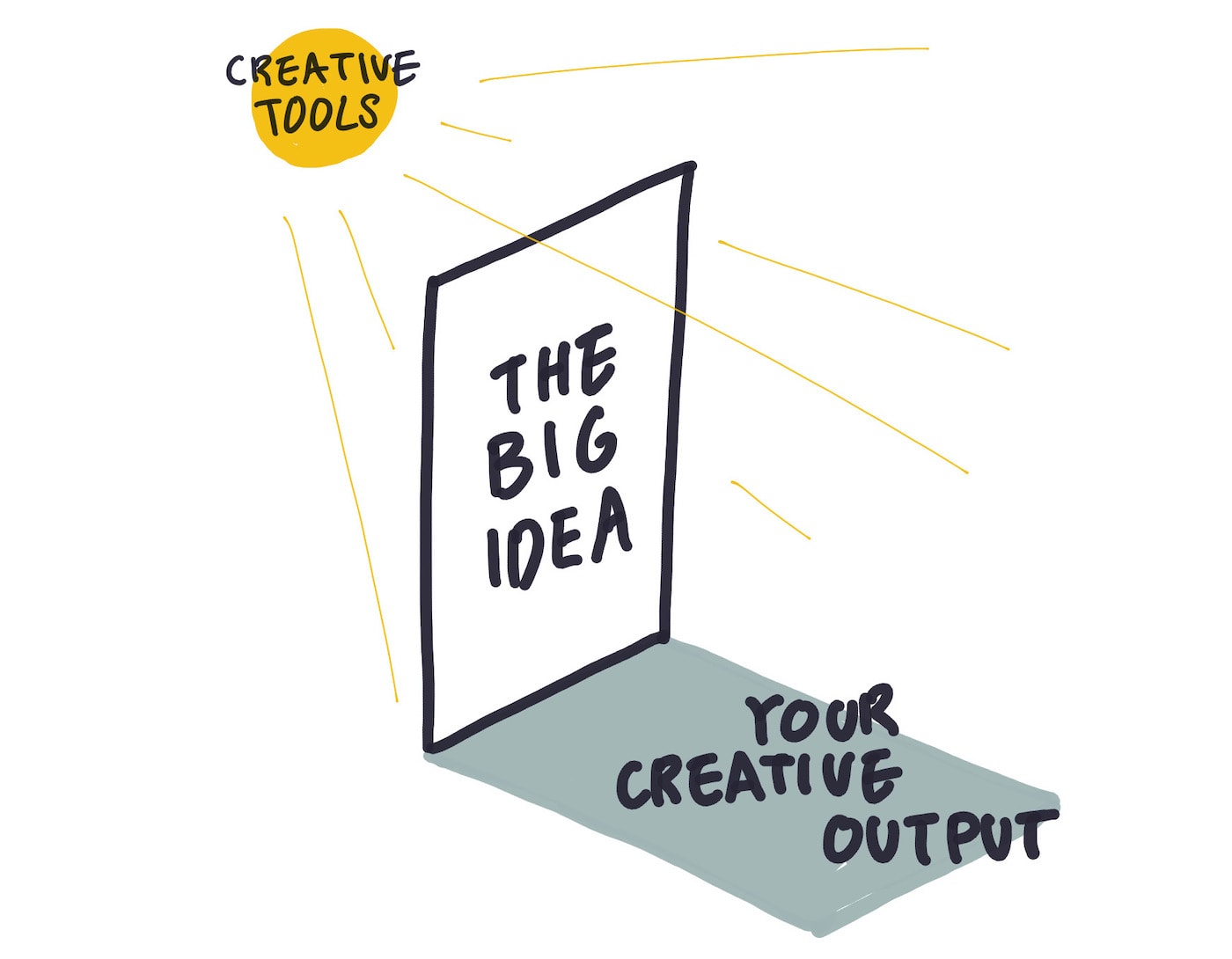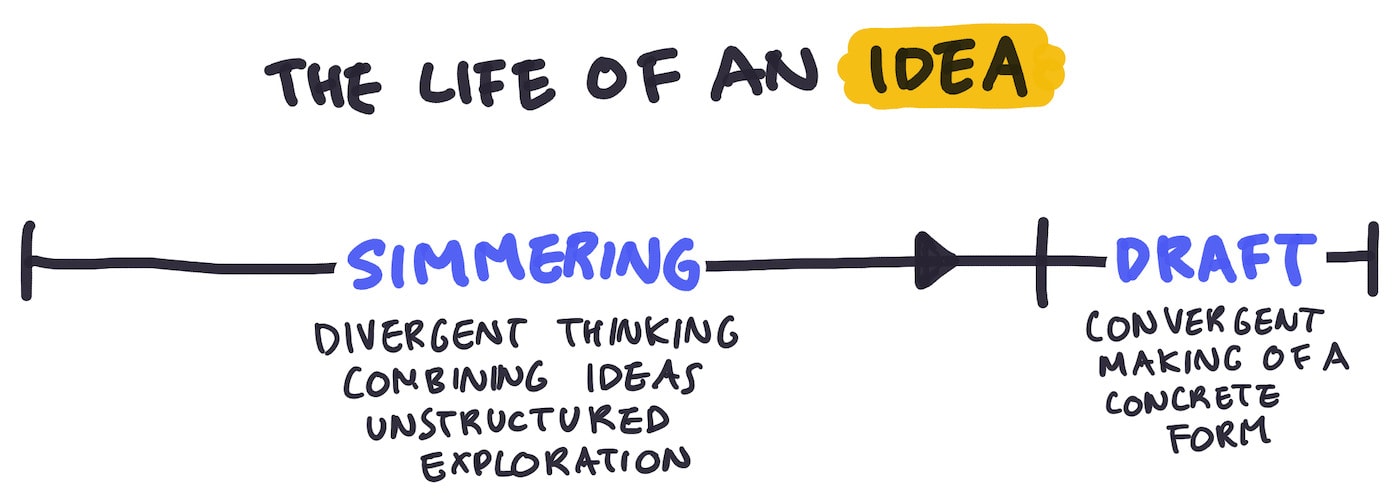When you create, the idea begins life in your mind. Like a mental picture of something you’re just about to draw, the idea in your mind is malleable. It doesn’t have a form yet, so it’s squishy and sticky, changing shape and globbing together with other ideas in a process we call thinking.
The moment you touch your pencil onto paper, the once-malleable idea is knocked into something solid. With the pencil in your hand, you begin to trace out the outlines of the idea, molding it into something material, something you can touch. With your pencil, you’re casting a shadow of the idea in your mind and projecting it into the real, material world of tactile, visible things. With every line and stroke, the idea in your mind takes on a firmer shape. The more details you add to your drawing or writing, the less malleable and soft the idea floating in your mind becomes, until you mold out of the physical reality a shadow of what you see with your mind’s eye. When you’re done, you hand off your sketch to another person, who can look at your handiwork and imagine in their mind the mental image that would have cast just such a shadow onto the real world.
This is the process of creation: molding the malleable ideas in your mind into something definite, then casting a shadow of that mental image into the material world.

In this process, the tools you use to mold the materials of reality are the light that casts the shadow. The pencil, the brush, the keyboard, human language, computer language, photography, music … these are the tools available at your disposal for you to sculpt out of the clay of reality what you see in your mind’s eye. The sharper the tools you use to carve out shadows of your ideas, the clearer the ideas in your creative work will become.
But creation isn’t simply the act of committing an image onto paper or screen. The process begins much earlier, at the birth of an idea.
As I’ve improved my writing, I’ve noticed that there are two distinct phases to my writing process. Long before I start typing any words, someone or something plants a seed of an idea in my mind. Sometimes it’s from a conversation, sometimes it’s from a blog or a book, or occasionally from personal experience. Once the idea lands in my mind, it simmers. A seed of an idea isn’t mature enough yet to be committed into a real form, but collides and merges with other ideas in my mind. The more I can feed the idea with feedback, conversations, and other inspiration, the faster it evolves into something clearer and more definite. All throughout, the idea stays soft and malleable.
At some point, I decide to make something out of it, so I start drafting. It might be a sketch for a drawing or an outline for a blog post, or maybe a wireframe for an app. Once I start giving the idea a form in the real world – start casting the shadow – the idea becomes less malleable. Once I’ve committed to a form, the idea can only shift in the small details, until I’ve drawn and written and designed out all the details, and the idea becomes final. Published. Shipped.

The longer I spend with an idea in the simmering phase of my workflow, the more polished the final piece becomes. In other words, the longer I keep the idea in a soft, malleable state in my mind, the more freely it can grow and evolve from new information. Only when I have a clear image of the idea in my mind’s eye can I begin the process of committing to a form, drafting something real in front of me.
Free-hand drawing is a small model of this process. To draw something free-hand, you need to first visualize what you’ll draw in your mind’s eye. The clearer you can see the image in your mind, the quicker and better you’ll be at reproducing it on paper. It doesn’t make sense to start sketching without a clear image, and then iterate your way to a great final picture – you need to mold a clear mental picture before even creating a sketch of your idea.
And yet, when we work with bigger, more complex ideas, we seem all too eager to jump straight to putting ideas on paper. We’re often too eager to outline, organize, sort, wireframe, storyboard, sketch, and draft out ideas from the beginning, when the idea is just a small malleable seed, with the excuse that we can start iterating faster on the idea if it’s on paper.
But putting a shape to an idea slows down how quickly it can change in your mind. You trade off the malleability of your idea for the permanence of a physical form. Too often, we don’t realize the compromise we’re making. Like clay, when we shine light on an idea to cast its shadow into something physical, it starts to become rigid. You can’t always iterate your way into completely new perspectives.
To invent completely new ideas and tell more original stories, we should spend more time simmering on our ideas in the dark, molding them into a million different shapes, before shining the light and broadcasting what you see out from your mind into the rest of the world. Your creative challenge in this world isn’t to make something out of nothing, as it might first appear. Instead, it’s to sift through the tens of thousands of thoughts you think every day, grow them and care for them in the safety of the darkness. And when you stumble into the clearest ones ready to be pushed out into reality, find the brightest light you can find, and cast a crisp shadow onto your medium of choice, be it stories or essays or pictures or products.
Once your idea finds life in the material world, other people might discover that your idea is just what they needed to feed the ideas simmering in the darkness of their minds. Perhaps they, too, will grow their ideas into fruition, and cast shadows of their own mind-worlds back into your reality.
And the cycle continues.
Thanks to Jacob Cole and Tanthai Pongstien, whose thoughtful conversations with me led to some of the ideas in this post.
← The long future of artificial intelligence
I'm joining Ideaflow to build a universe of better tools for ideas →
I share new posts on my newsletter. If you liked this one, you should consider joining the list.
Have a comment or response? You can email me.